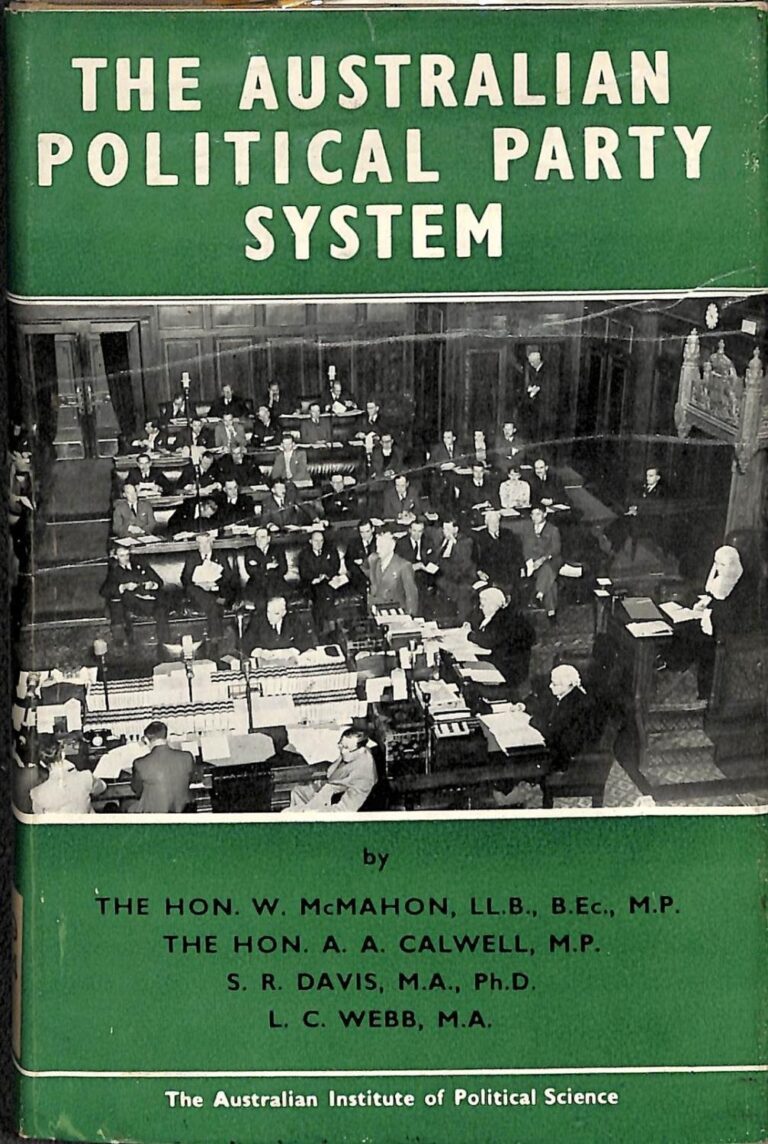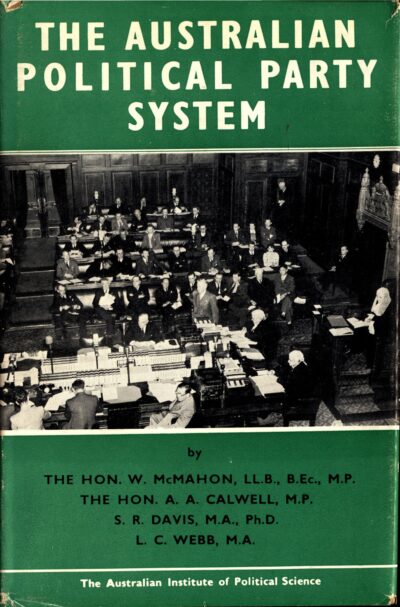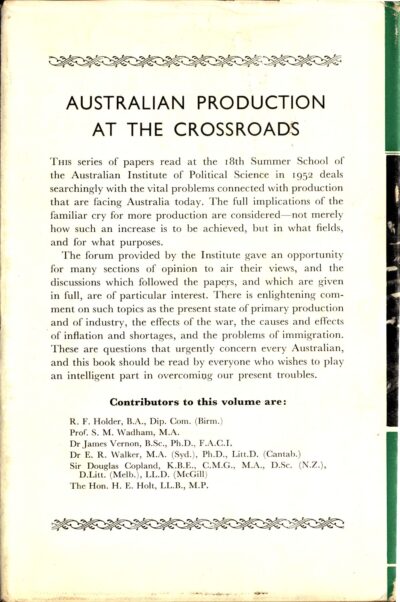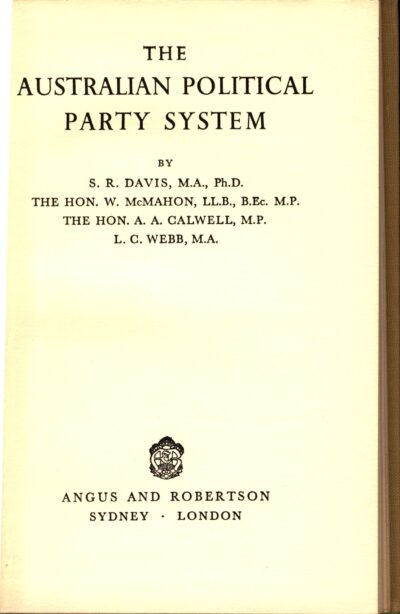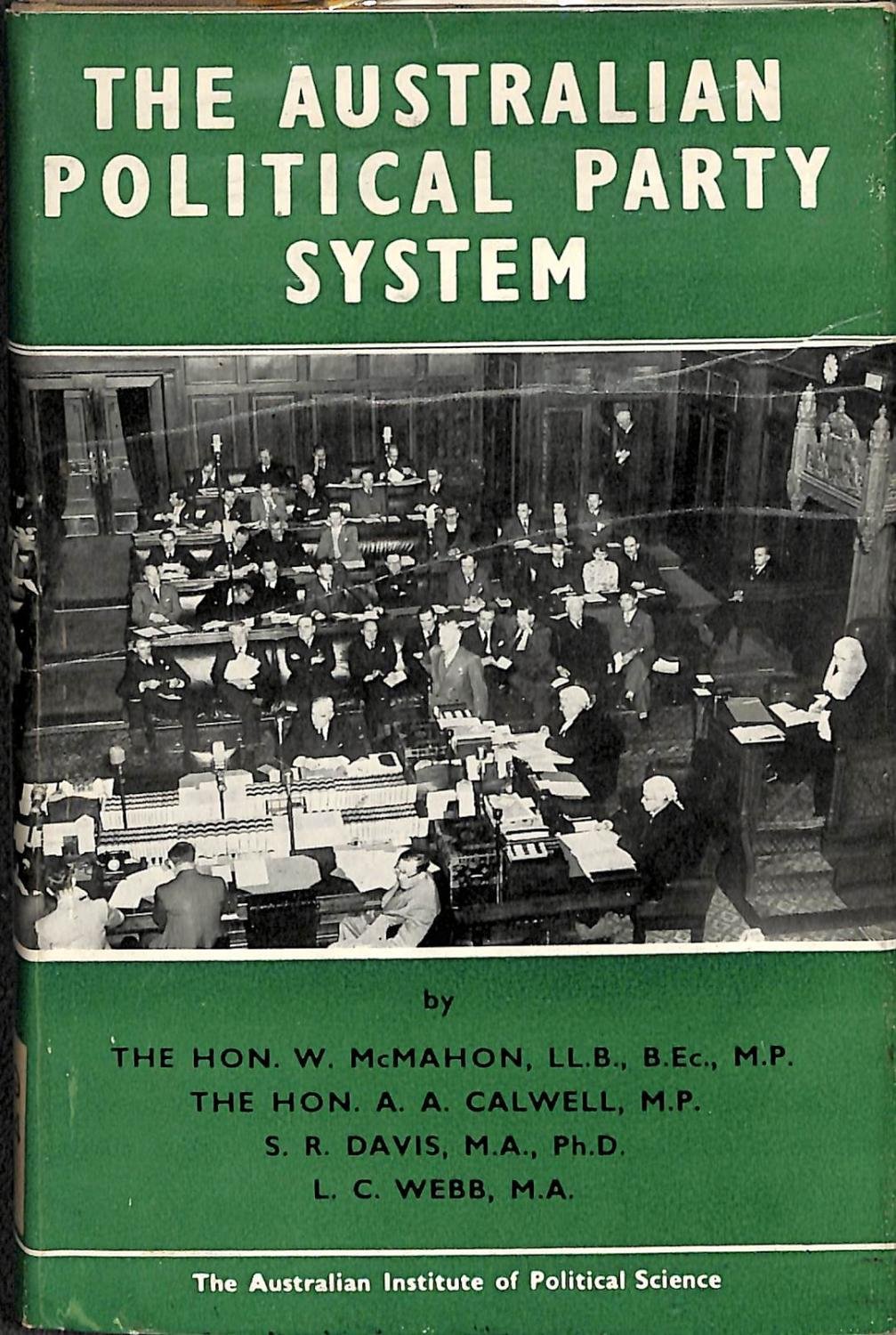S.R. Davis et al., The Australian Political Party System (1954)
The Australian Political Party System is a book of papers from the First Winter Forum of the Victorian Group of The Australian Institute for Political Science. Published in 1954 when the Liberal Party was just a decade old, the book provides a fascinating examination of the Australian party system at the time in which it was first settling into its modern form (though prior to the more recent phenomena of the rise of Senate-based minor parties).
The book begins with an introduction by Dr S.R. Davis, who was then a Senior Lecturer in Political Science at the University of Queensland. Davis notes that political conflict is inherent to human societies, but that Australia’s party system represents a broad acceptance of the free contest of ideas and freedom of association. This party system is traced back to Britain and two cardinal events, namely the emergence of Cabinet government which transferred from the Sovereign to Parliament the choice of the ministry, and the advent of widespread suffrage which necessitated broad-based political organisations.
Davis argues that parties are the necessary facilitators of modern parliamentary democracy, without which ‘the notion of representative and responsible government is meaningless’. He notes that parties have been subject to intense criticism from their earliest emergence, that they are often dismissed as sectional and stifling, leading to a ‘nostalgia for the leisured debates of another age’. Nevertheless, ‘modern critics are at least agreed that to destroy the party system is to undermine our institutions far more completely than the damage they suffer from the excesses of party spirit’.
There follows an examination of the philosophical and organisational basis of Australia’s two major parties (with the notable absence of the Country Party), provided by significant party figures. The Liberal Party chapter is written by William McMahon, then Minister for the Navy, who unpacks the philosophy of liberalism from first principles, and notably without any reference to party ‘founder’ Menzies. While noting that liberals oppose dogmas and have a great deal of pragmatism, he starts with four assumptions: that the individual rather than the state is the central feature of society, man possesses the capacity to think and act purposefully – directly shaping change in society as opposed to Marxist theories of materialist determinism, original sin proves that all men are flawed and power should not be concentrated in the hands of any one man, and finally that man possesses free will and the ability to make moral decisions.
On this basis he defends the centrality of individual freedom which needs to be protected from the encroaches of the state, quoting extensively from a diverse range of figures including Hayek, Keynes, Marx, and Schumpeter. Liberals are said to have a fundamental respect for institutions and processes, such as the rule of law, as the essential safeguards of the individual and stability, in contrast to socialists who McMahon claims often view institutions and processes as obstacles to achieving their ends. He lauds the immense prosperity and progress produced by capitalism and individual incentive, while maintaining that these can be harnessed for the common good. To dismantle capitalism in an effort to produce equality ‘would be criminal lunacy’, he argues, as it would destroy ‘the very mechanism on which the realization of higher standards of living and social justice ultimately depend’.
The Labor perspective is provided by Arthur Calwell, who was then the Deputy Leader under H.V.Evatt. In contrast to McMahon’s emphasis on first principles, Calwell’s account is rooted in the history of the Labor movement and of its controversial ‘Socialization Objective’. This historical narrative begins with Britain’s Chartists and the Eureka Stockade, before arriving at Labor’s emergence in the turbulent decade of the 1890s. He covers the introduction of the ‘pledge’, which bound Labor parliamentarians to follow the dictates of their organisation, and to critics destroyed their ability to act as true representatives of their electorate and exercise individual moral judgment. In typical Calwell-ian fashion, he defends the White Australia Policy as Labor’s specific interest, arguing that ‘the national desire to preserve the homogeneity of the Australian people would probably be weakened considerably if it were not for the Labour Party’s watchfulness and determination not to allow fundamental alterations in our immigration laws’.
Like McMahon, Calwell is insistent that his party is ruled by pragmatism, which informs its gradualist ‘approach to the problem of socialism’. The exception was cases like bank and airlines nationalisation, where the party had ‘taken urgent action, but only because it believed delay would enable the supporters of great vested interests to harm the common good and thwart the electoral mandate given at the 1946 Elections in respect of the Airlines Nationalization Act and the Commonwealth Bank Act, both passed by Parliament in 1945’.
The book concludes with a chapter by L.C. Webb, Reader in Political Science at the recently established Australian National University. Webb traces the emergence of Australia’s two-party system in the first decade of the Commonwealth culminating in the unlikely fusion of the two fiscal parties in opposition to Labor, the pledge and Reid’s ‘Socialist Tiger’ which ‘now in its forty-seventh year is still the principal election equipment of the non- Labour parties’. He then covers the advent on the Country Party, noting that the introduction of preferencing allowed a great multiplicity of candidates without destroying the essential two-party nature of the political contest (though he does note that Australia is less rigidly two-party with preferencing than it would be without it). Webb suggests that the Country Party was of great benefit to conservative forces, allowing them to use country sentiment to monopolise seats that would otherwise face more open electoral competition. He notes that some of the defining features of Australian politics are the federal nature of political organisations which has endured despite centralising power in the Commonwealth, and the tendency of Australian politics to lean towards the centre.
You might also like...
Sign up to our newsletter
Sign up for our monthly newsletter to hear the latest news and receive information about upcoming events.

